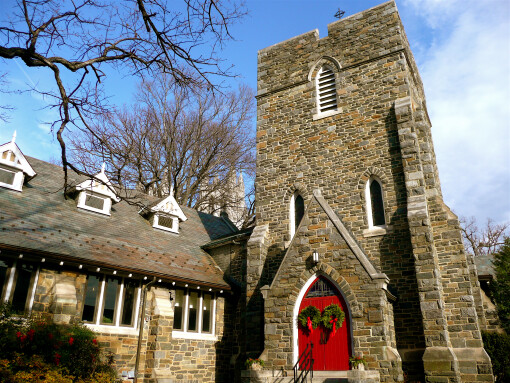To See Jesus

Series: Pentecost
Speaker: The Rev. Deborah Meister
Tags: conversion, righteous, salvation, zacchaeus
Today’s Gospel is a story about new life: our longing for it, and its cost. I have strong affection for Zacchaeus, partly because he is small, like me. But mostly because of what we know about him: he longed to see Jesus. So do I! So do most of us, I think, who gather here on Sundays. People come to church for a myriad of reasons, and only a foolish pastor would presume to believe she knows them all. But underneath most of those reasons, we long to see Jesus.
We long to see the man, and we long to see the world that he has promised will come: a world of peace, of justice, of simplicity and joy. A world characterized by Shalom. Very often, I hear people say that the world around them has destroyed their faith. They look around and see injustice, cruelty, racism, the ruin of our environment, all the ways we reduce one another to objects to be bought and sold and preyed upon, and they cannot believe in God. For me, the opposite is true. I see all that — there are times it is hard for me to turn my eyes away from it — and in spite of the wreckage around me, because of the wreckage around me, I need to believe in God. I need to believe that there is hope. I need to believe that inhumanity does not have the final word, that “the worst is not the last.”[1] I need to believe that, while “the arc of the moral universe may be long,… it bends toward justice.”[2] And so, like the prophet Habbakuk, I stand on the rampart and look for the dawn, believing that “there is still a vision for the appointed time.” (Hab 2:1, 3)
Often, I feel too small to see it. None of us sees more than a tiny corner of this world; not one of us has seen the truth whole. And so I have to smile when Zacchaeus climbs his tree. At that time, of course, a tree or a tall hill would have been the closest you could come to seeing from a height. There were not apartment buildings, airplanes, elevators: all the things that have altered our sense of scale. And so Zacchaeus, who cannot see over the crowd, clambers up his sycamore, which was really a fig, and isn’t even a very tall tree. In my mind, it is always a young tree, too young to bear the weight of a small, pudgy man, which is what I imagine Zacchaeus to have been. And so, as he climbs, the tree bends and shivers; it rocks beneath his weight. But no matter how much it trembles, how much it seems to shake, the man clings to the tree for dear life, because, somehow, he knows that Jesus is life, and that tree is his chance to see Jesus.
And then, the unthinkable happens. Jesus passes by and looks up and sees Zacchaeus: out of all that pressing crowd, Jesus saw the one who hungered and thirsted to see him, so much that he surrendered his dignity and was willing to look like a fool. And Jesus calls out to him by name and invites him to dinner, and the small man slides down from the tree, all eyes upon him, and cries out, “Half my possessions, Lord, I will give to the poor, and if I have defrauded anyone of anything, I will pay back four times as much.” (Luke 19:8) And Jesus exults, “Today salvation has come to this house.” (Luke 19:9) It is the classic story of conversion, isn’t it: the rich man who has grown wealthy by collaboration and extortion finds God, repents, and makes good his debt to others. The man who longed to see Jesus gets his wish, and the result is a life transformed. Even the tree, it turns out, is probably symbolic. The Greek word for “sycamore” shares a root with the word for “extortioner,” so when Zacchaeus climbs that particular tree, he is revealed to the eyes of the crowd in more ways than one.[3] Zacchaeus climbs the tree as the proverbial bad fruit, but he comes down to live a fruitful life.
Sometimes, God happens like that. Once, I met a person who was driving past this church and saw our sign. And when this person read the words, ”You belong here,” something deep within said “Yes, I do.” The person was not a believer, but God reached into her life and changed her, and she walked in the doors and belonged. Sometimes, it really is that simple.
But not always, which is why Zacchaeus is so interesting to me. The New Revised Standard Version of the Bible, which we read each Sunday, is the most accurate translation out there[4], but it gets this one wrong. When Jesus sees Zacchaeus, he does not cry out, “Half my possessions, Lord, I will give to the poor.” There is no future in it. What he actually says is, “Lord, half my goods I give to the poor,” and he doesn’t mean, “Right now.” Rather, the verb is in a tense which connotes habitual action, so it should be translated, “Lord, I always give half my possessions to the poor, and if I find out that I have become involved in fraud, I pay back four times as much.” In other words, Zacchaeus is not an extortioner who makes good; rather, he is a man who lives in a corrupt world, but who has been seeking to live a righteous life all along.
That makes more sense to me. People have confided in me all my life; in buses or on trains or at dinner parties, they pull me aside and tell me extraordinary things. And while it sometimes happens that God reaches down and changes the trajectory of a life, more often it seems that God comes to those who have been reaching in his direction for a long time. Not that they would say – or even know -- that was what they were doing. But there comes a time in the life of a frivolous person when it all turns to dust: when the dancing and the dating and the striving for power no longer seem to hold out their original promise. Then the desire of your heart turns toward a life of meaning; then you want something that will last.
And if Zacchaeus was such a person, what then? Does the story lose its meaning? I don’t think so. Whatever was in Zacchaeus’ heart, whatever drove him to try to see Jesus that day, the people around him had made assumptions. They assumed he was corrupt, because he was a tax collector. They assumed he enjoyed collaboration, when maybe it was the only choice he had. They assumed he had turned his back on his people, when he had been one of them all along. So when Jesus calls out to him, Zacchaeus is restored: he is restored to his people, to his community. The misguided assumptions people had made, thinking they knew the truth, were shattered, and he became a man in their eyes once again.
We need some of that, in this nation. We need to learn to reach beyond our casual assumptions, beyond our tendency to stereotype one another. This election has left us a divided people, or has revealed the divisions that were there all along. But none of us sees more than a tiny corner of this world; none of us sees the truth of another’s life. And so, while we ache to see Jesus, we need to learn to see one another as well. Like Zacchaeus, we need a new perspective.
This fall, J. D. Vance has made headlines with his book, Hillbilly Elegy. At one point, he writes, “Whenever people ask me what I’d most like to change about the white working class, I say, ‘The feeling that our choices don’t matter.’” Many of us gathered here, who are far from Appalachia, have the same feeling. But Zacchaeus shows us that our choices do matter. Whether he was converted that day or whether he was reaching toward God all along, Zacchaeus acted. Small in stature, he was audacious in hope and courageous in resolution. He was willing to put his dignity aside; he was willing to climb that tree; he was willing to risk being risible in the eyes of everyone. He was willing to do all that because of the hope that had been promised.
My friends, it’s not enough to stand on the ramparts and watch. It’s not enough to wait for the vision to come. The call of a Christian is not to be an observer, but to be light for the world and bread for the hungry, to become a reason for hope.
No one said it would be easy. Long ago, decades after the Hebrews were taken into exile in Babylon, a group of them were permitted to return to their home. When they got there, they found Jerusalem a heap of rubble, and the Temple in ruins. But they took heart and began to build again, toiling through the hot summer days and the bitter cold of winter to make their vision real, to build their home again. And when the neighbors didn’t like it, when their neighbors threatened them and plotted against them and gathered for an attack, they kept on building, with their sword in one hand and their shovel in the other, because they remembered Jerusalem: they had heard the stories; they could almost taste it, and now its soil was under their feet and nothing was going to stop them from making that vision real. Nothing was going to stop them from having a home again.
The thread that runs from those ancient builders, through Habbakuk’s lonely vigil, through Zacchaeus’s audacity, and all the way to us is desire: the desire to see God. The desire to see the world God promises. A world where promises are kept, where brokenness is redeemed, where new life rises from the ashes of the old, and where men and women from every tribe and race and people and nation stand as one within the house of God and call one another brother and friend. A world where we choose one another.
A world we choose.
[1] John Claypool.
[2] Martin Luther King, Jr., possibly citing Theodore Parker.
[3] Lu Magness, “Who Cares that it was a Sycamore?” Pepperdine Digital Commons, 1997.
[4] The NIV is its peer.
 Welcome to St. Alban’s Church! Every Sunday, and most days in between, people gather in this place to worship, to learn, to grow, to share the joys and struggles of our lives, and to seek God’s grace in the midst of our lives. We do not come because we have it all figured out, but because we are seeking light on the way. We come as we are and welcome one another.
Welcome to St. Alban’s Church! Every Sunday, and most days in between, people gather in this place to worship, to learn, to grow, to share the joys and struggles of our lives, and to seek God’s grace in the midst of our lives. We do not come because we have it all figured out, but because we are seeking light on the way. We come as we are and welcome one another.

